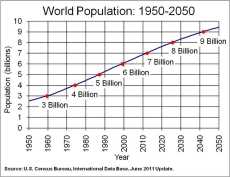The World Population at 7 Billion
The World Population at 7 Billion
The world’s population will shortly reach 7 billion. The United Nations estimates the world will reach this milestone on October 31, 2011. The U.S. Census Bureau estimates the world population will pass 7 billion on March 12, 2012 (see graph; for a link to Census Bureau’s estimates of today’s population, as well as annual midyear estimates from 1950 to 2050, see //www.census.gov/population/international/data/idb/worldpopinfo.php).
While the true world total population is not known, it is independently estimated by both the United Nations and the Census Bureau. Both organizations begin with separate population estimates for individual countries and areas throughout the world and then compile them into a world count. Country estimates typically are based on national census counts, which usually are taken only once a decade. Thus, to estimate each country population beyond the latest census year requires separate projections based on current demographic trends, which are typically determined using whatever demographic data (sometimes limited) are available. Clearly, there is some uncertainty in world population estimates. Despite some differences, the world population estimates of the United Nations and the Census Bureau are remarkably close, different by less than one half of one percent in 2011.
The rapid increase in the Earth’s population in recent decades is because of an excess of births over deaths. Although birth rates and death rates have both declined sharply since the 1960s, death rates have declined more rapidly than birth rates. The cumulative effect of the excess of births over deaths in recent decades has led to a successive attainment of billion-person milestones every 12 or 13 years.
For instance, according to Census Bureau estimates, the Earth’s population reached 4 billion in 1974, 5 billion in 1987, and 6 billion in 1999 (these figures are derived from the International Data Base, which compiles demographic estimates for 228 countries and areas of the world). In the future, as fertility continues to fall, it will take longer to add another billion. The Census Bureau currently expects that 14 years will pass before the world reaches the next milestone of 8 billion (in 2026) and then another 16 years before it reaches 9 billion (in 2042). The exact date at which such thresholds will be passed is uncertain, of course, since it depends on future birth and death rates. Even more uncertain is the future year at which the Earth’s population may reach a tipping point and begin to decline.
Perhaps more important than the global population size are underlying demographic trends. One is that population growth is uneven throughout the world – many countries have very low fertility and slow or even negative population growth, while others, particularly developing countries, have high fertility (differences in mortality and migration also affect population growth). Thus, an increasing share of the world’s future population is likely to reside in the developing countries of the world. Other key trends have emerged because of the decline of fertility and mortality. One trend emerging from low fertility is population aging – the increased share of the population at older ages. Population aging presents challenges, particularly for those societies that have limited resources to support this group.




